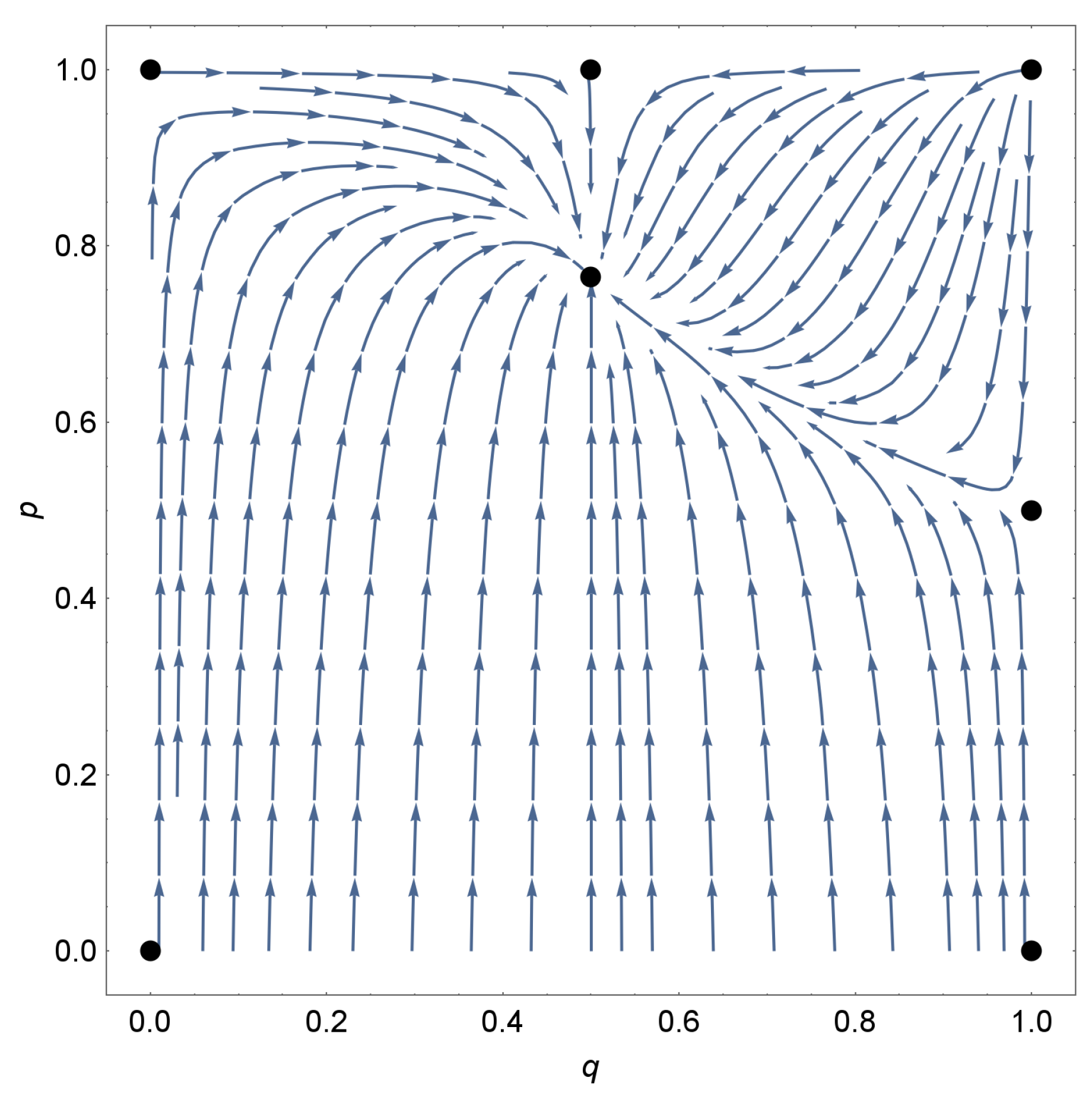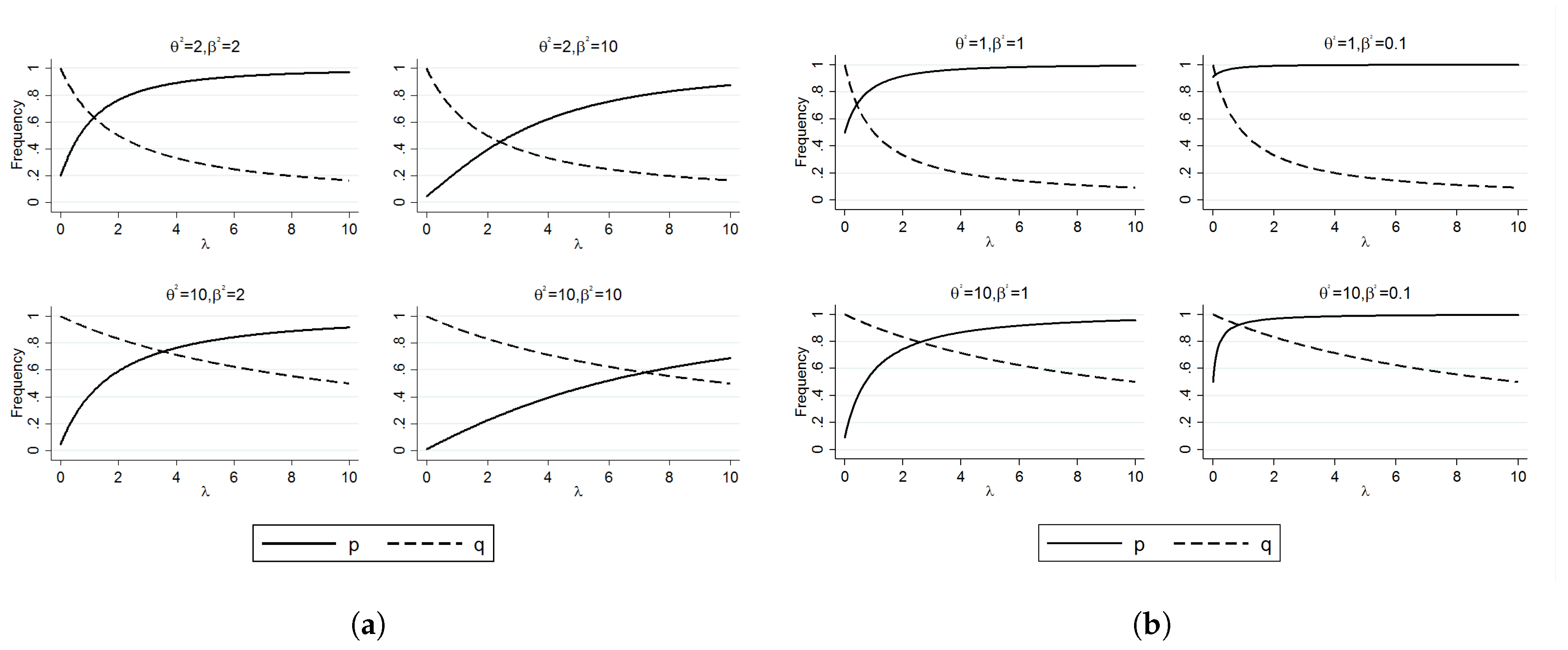Cultural Transmission and Extortion
Abstract
1. Introduction
1.1. Key Result
1.2. Prior Literature
2. Basic Contest
3. Cultural Transmission
4. Contest with Cultural Transmission
5. Conclusions
Acknowledgments
Conflicts of Interest
Appendix A
References
- Olken, B.A.; Barron, P. The simple economics of extortion: Evidence from trucking in aceh. J. Political Econ. 2009, 117, 417–452. [Google Scholar] [CrossRef]
- Klitgaard, R.E. Controlling Corruption; University of California Press: Berkeley, CA, USA, 1988. [Google Scholar]
- Svensson, J. Eight questions about corruption. J. Econ. Perspect. 2005, 19, 19–42. [Google Scholar] [CrossRef]
- Hauk, E.; Saez-Marti, M. On the cultural transmission of corruption. J. Econ. Theory 2002, 107, 311–335. [Google Scholar] [CrossRef]
- Fisman, R.; Miguel, E. Corruption, norms, and legal enforcement: Evidence from diplomatic parking tickets. J. Political Econ. 2007, 115, 1020–1048. [Google Scholar] [CrossRef]
- Cameron, L.; Chaudhuri, A.; Erkal, N.; Gangadharan, L. Propensities to engage in and punish corrupt behavior: Experimental evidence from Australia, India, Indonesia, and Singapore. J. Public Econ. 2009, 93, 843–851. [Google Scholar] [CrossRef]
- Barr, A.; Serra, D. Corruption and culture: An experimental analysis. J. Public Econ. 2010, 94, 862–869. [Google Scholar] [CrossRef]
- Banuri, S.; Eckel, C. New Advances in Experimental Research on Corruption: Chapter 3—Experiments in Culture and Corruption: A Review; Emerald Group Publishing: Bingley, UK, 2012. [Google Scholar]
- Gachter, S.; Schulz, J.F. Intrinsic honesty and the prevalence of rule violations across socieites. Nature 2016, 531, 496–499. [Google Scholar] [CrossRef] [PubMed]
- Chaudhuri, A.; Paichayontvijit, T.; Sbai, E. The role of framing, inequity, and history in a corruption game: Some experimental evidence. Games 2016, 7, 13. [Google Scholar] [CrossRef]
- Bisin, A.; Verdier, T. The economics of cultural transmission and the dynamics of preferences. J. Econ. Theory 2001, 97, 298–319. [Google Scholar] [CrossRef]
- Montgomery, J. Intergenerational cultural transmission as an evolutionary game. Am. Econ. J. Microecon. 2010, 2, 115–136. [Google Scholar] [CrossRef]
- Bisin, A.; Verdier, T. Handbook of Social Economics: Chapter 9—The Economics of Cultural Transmission and Socialization; Elsevier: North Holland, The Netherlands, 2011. [Google Scholar]
- Gunnoe, M.L.; Moore, K.A. Predictors of religiosity among youth aged 17–22: A longitudinal study of the national survey of children. J. Sci. Study Relig. 2002, 41, 613–622. [Google Scholar] [CrossRef]
- Dunn, J.S.; Kinney, D.A.; Hofferth, S.L. Parental ideologies and children’s after-school activities. Am. Behav. Sci. 2003, 46, 1359–1386. [Google Scholar] [CrossRef]
- Hassan, K.E.; Kahil, R. The effect of “living values: An educational program” on behavior and 193 attitudes of elementary students in a private school in lebanon. Early Child. Educ. J. 2005, 33, 81–90. [Google Scholar] [CrossRef]
- Smith, J.M.; Price, G.R. The logic of animal conflict. Nature 1973, 246, 15–17. [Google Scholar] [CrossRef]
- Smith, J.M. Evolution and the Theory of Games; Cambridge University Press: Cambridge, UK, 1982. [Google Scholar]
- McElreath, R. Reputation and the evolution of conflict. J. Theor. Biol. 2003, 220, 345–357. [Google Scholar] [CrossRef] [PubMed]
- Doebeli, M.; Hauert, C. Models of cooperation based on the prisoner’s dilemma and the snowdrift game. Ecol. Lett. 2005, 8, 748–766. [Google Scholar] [CrossRef]
- Gintis, H. The evolution of private property. J. Econ. Behav. Organ. 2007, 64, 1–16. [Google Scholar] [CrossRef]
- McElreath, R.; Boyd, R. Mathematical Models of Social Evolution: A Guide for the Perplexed; University of Chicago Press: Chicago, IL, USA, 2008. [Google Scholar]
- Bowles, S.; Choi, J.-K. Coevolution of farming and private property during the early holocene. Proc. Natl. Acad. Sci. USA 2013, 110, 8830–8835. [Google Scholar] [CrossRef] [PubMed]
- Makowsky, M.D.; Smaldino, P.E. The evolution of power and the divergence of cooperative norms. J. Econ. Behav. Organ. 2016, 126, 75–88. [Google Scholar] [CrossRef]
- Broom, M.; Ruxton, G.D. Evolutionary stable stealing: Game theory applied to keptoparasitism. Behav. Ecol. 1988, 9, 397–403. [Google Scholar] [CrossRef]
- Vickery, W.L.; Giraldeau, L.-A.; Templeton, J.J.; Kramer, D.L.; Chapman, C.A. Producers, scroungers, and group foraging. Am. Nat. 1991, 137, 847–863. [Google Scholar] [CrossRef]
- Broom, M.; Luther, R.M.; Ruxton, G.D. Resistance is useless? Extensions to the game theory of kleptoparasitism. Bull. Math. Biol. 2004, 66, 1645–1658. [Google Scholar] [CrossRef] [PubMed]
- Cavalli-Sforza, L.L.; Feldman, M.W. Cultural Transmission and Evolution: A Quantitative Approach; Princeton University Press: Princeton, NJ, USA, 1981. [Google Scholar]
- Boyd, R.; Richerson, P.J. Culture and the Evolutionary Process; University of Chicago Press: Chicago, IL, USA, 1988. [Google Scholar]
- Henrich, J.; Gil-White, F.J. The evolution of prestige: Freely conferred deference as a mechanism for enhancing the benefits of cultural transmission. Evol. Hum. Behav. 2001, 22, 165–196. [Google Scholar] [CrossRef]
- Laland, K.N. Social learning strategies. Anim. Learn. Behav. 2004, 32, 4–14. [Google Scholar] [CrossRef]
- Efferson, C.; Lalive, R.; Richerson, P.J.; McElreath, R.; Lubell, M. Conformists and mavericks: The empirics of frequency dependent cultural transmission. Evol. Hum. Behav. 2008, 29, 56–64. [Google Scholar] [CrossRef]
- Mesoudi, A.; Lycett, S.J. Random copying, frequency-dependent copying and cultural change. Evol. Hum. Behav. 2009, 30, 41–48. [Google Scholar] [CrossRef]
- Rendell, L.; Boyd, R.; Cownden, D.; Enquist, M.; Erikkson, K.; Feldman, M.W.; Fogarty, L.; Ghirlanda, S.; Lillicrap, T.; Laland, K.N. Why copy others? insights from the social learning strategies tournament. Science 2010, 328, 208–213. [Google Scholar] [CrossRef] [PubMed]
- Molleman, L.; Pen, I.; Weissing, F.J. Effects of conformism on the cultural evolution of social behavior. PLoS ONE 2013, 8, e68153. [Google Scholar] [CrossRef] [PubMed]
- Bisin, A.; Verdier, T. A model of cultural transmission, voting and political ideology. Eur. J. Political Econ. 2000, 16, 5–29. [Google Scholar] [CrossRef]
- Bisin, A.; Verdier, T. On the cultural transmission of preferences for social status. J. Public Econ. 1998, 70, 75–97. [Google Scholar] [CrossRef]
- Tabellini, G. The scope of cooperation: Values and incentives. Q. J. Econ. 2008, 123, 905–950. [Google Scholar] [CrossRef]
- Calbuig, V.; Olcina, G. Cooperation and cultural transmission in a coordination game. J. Econ. Behav. Organ. 2009, 72, 188–201. [Google Scholar] [CrossRef]
- Bisin, A.; Topa, G.; Verdier, T. Cooperation as a transmitted cultural trait. Ration. Soc. 2004, 16, 477–507. [Google Scholar] [CrossRef]
- Tullock, G. Efficient Rent Seeking; Texas A&M University Press, College Station: College Station, TX, USA, 1980. [Google Scholar]
- Saez-Marti, M.; Sjogren, A. Peers and culture. Scand. J. Econ. 2008, 110, 73–92. [Google Scholar] [CrossRef]
- Guiso, L.; Sapienza, P.; Zingales, L. Alfred marshall lecture social capital as good culture. J. Eur. Econ. Assoc. 2008, 6, 295–320. [Google Scholar] [CrossRef]
| 1. | The results of the model are similar if both Type-A’s and Type-B’s value exerting effort, but Type-A’s place a greater value on winning the contest compared to Type-B’s. As long as there is a difference in the valuation of the contest between the two types, the results will be similar. Norming Type-B’s value to zero simplifies the presentation of the results. |
| 2. | Assuming different linear costs of efforts between the groups gives predictable results. For example in subsequent analysis, assuming costs are higher for individuals in population one leads to a higher equilibrium fraction p and a lower equilibrium fraction q. The reverse holds as well assuming costs are higher for population two. As a result, similar costs were assumed for ease of exposition. |
| 3. | It is assumed that both Type-Cs and Type-Ds via their position of authority receive some fixed benefit or salary that is independent of their decision to extort from citizens in population one. This benefit for ease of notation is assumed to be zero, since, as long as this benefit is the same for both types, the results will be unchanged. |
| 4. | See Appendix A for details. |
| 5. | If , then any q can be an equilibrium. In this case, there is no extortion so there is no payoff difference between type A’s and B’s. |


| Type-C’s | Type-D’s | |
|---|---|---|
| Type-A’s | ||
| Type-B’s |
| Type-C’s | Type-D’s | |
|---|---|---|
| Type-A’s | ||
| Type-B’s |
© 2018 by the author. Licensee MDPI, Basel, Switzerland. This article is an open access article distributed under the terms and conditions of the Creative Commons Attribution (CC BY) license (http://creativecommons.org/licenses/by/4.0/).
Share and Cite
Ridinger, G. Cultural Transmission and Extortion. Games 2018, 9, 49. https://doi.org/10.3390/g9030049
Ridinger G. Cultural Transmission and Extortion. Games. 2018; 9(3):49. https://doi.org/10.3390/g9030049
Chicago/Turabian StyleRidinger, Garret. 2018. "Cultural Transmission and Extortion" Games 9, no. 3: 49. https://doi.org/10.3390/g9030049
APA StyleRidinger, G. (2018). Cultural Transmission and Extortion. Games, 9(3), 49. https://doi.org/10.3390/g9030049





